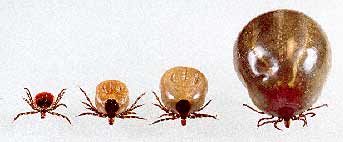

A tick is part of the arachnid family, which also includes mites, spiders, and scorpians . A tick attaches itself to the skin of an animal and sucks blood. There are hundreds of kinds of ticks on the planet, and they can be found almost everywhere. The two types of ticks that many people talk about are the deer tick and the dog tick.
The deer tick is about the same size as the head of a pin, and it is found in many parts of the United States. One of the diseases that deer ticks can carry is Lyme disease, especially in New England and parts of the Midwest. (Lyme disease gets its name from the place where it was discovered — Lyme, Connecticut, which is in New England.)
Dog ticks are very common and can be up to ½ inch long. If you have a dog, chances are pretty good that you’ve seen a dog tick on its coat. One disease that this type of tick can carry is called Rocky Mountain spotted fever.
A person who gets bitten by a tick usually won’t feel anything at all. There might be a little redness around the area of the bite.
Parents should check children for ticks after playing or hiking in the woods. Since CSA is an open campus with wooded areas, check after school also. Bath time is a good time to check all areas. Check your child’s head (including scalp), back, neck, armpits, and groin area. If you ever find a tick on your child, remove it. Using tweezers, grab the tick as close as possible to your child’s skin, and pull the tick off in one motion. Don’t cover the tick with petroleum jelly, fingernail polish, or any other substance, since these don’t help the tick come out and can make things more complicated. Do NOT try to burn it off with a flame.
If part of the tick stays in your child’s skin, don’t worry — it will eventually come out. Once the tick is removed, put the tick in a small container or zip-locked bag. Call your doctor to see if he/she wants to examine your child or see the tick.
Doctors don’t need to treat most tick bites. But if the tick was carrying Lyme disease or Rocky Mountain spotted fever and passed it on, any symptoms that might mean you are sick will be treated with antibiotics. Your doctor might ask to see the tick to help make a diagnosis. If these diseases are treated early on, it’s rare for there to be any lasting changes to a person’s health.
Ticks like spending time close to the ground in order to jump on people or animals that pass by. If you or your child are hiking in the woods, wear long sleeves and long pants, and tuck your pants into your socks. Wearing an insect repellent also might help. Apply one that contains 10% to 30% DEET.
Dogs are also very good at picking up ticks in their coats, so bathe your dog with a tick shampoo and give your dog a tick collar.